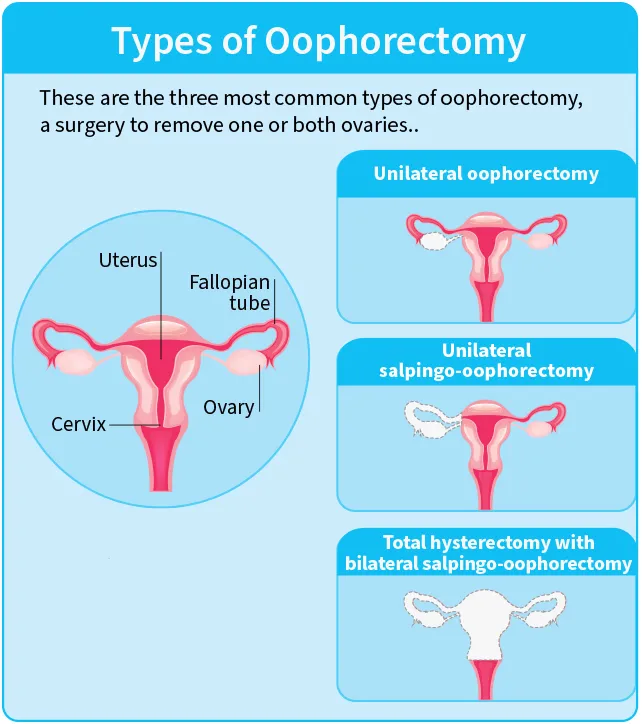What Is an Oophorectomy?
An oophorectomy is surgery to remove one or both of your ovaries. You might also hear it called ovary removal surgery.

Reasons for Oophorectomy
There are many reasons your doctor may recommend surgery to remove one or both of your ovaries.
They include:
- Benign tumors, which are noncancerous growths
- BRCA gene mutations, which are changes in your DNA that make you more likely to have breast or ovarian cancer
- Cysts, a type of noncancerous tumor
- Ectopic pregnancy
- Endometriosis, a condition where cells that normally grow inside your uterus start growing elsewhere
- Ovarian cancer, which is a cancer that starts in your ovaries
- Pelvic inflammatory disease (PID), which is when you get an infection in or around your ovaries (including a tubo-ovarian abscess)
- Torsion of the ovary, a condition where your ovary twists around its stalk, where the blood supply is. This might cause you serious pain.
- Pelvic pain: An oophorectomy can also treat chronic pelvic pain or pain after an ovary-sparing hysterectomy.
Oophorectomy Procedure
There are several types of oophorectomies. The one you’ll get depends on the medical condition you’re being treated for:
- Unilateral oophorectomy: Removal of one ovary
- Bilateral oophorectomy: Removal of both ovaries
- Salpingo-oophorectomy: Removal of an ovary and fallopian tube (the small organ that guides eggs from your ovary to your uterus)
- Bilateral salpingo-oophorectomy: Removal of both ovaries and both fallopian tubes
- Hysterectomy with salpingo-oophorectomy: Removal of your uterus as well as one or both ovaries and fallopian tubes
Usually, you’ll get general anesthesia for surgery and won’t be awake.
There are a few ways the surgery can be done. Your doctor will suggest the method based on your particular situation:
An open procedure. This is the traditional way to perform the surgery. Your doctor will make one medium to large cut in your belly. This lets them see your ovaries. They will then separate each ovary from other tissues and arteries that supply blood, and then remove them.
Laparoscopic surgery. Your surgeon will insert a small camera, called a laparoscope, through a tiny cut in your belly button. It lets them see your ovaries. The camera sends images to a monitor, just like a TV or computer screen. The doctor will make other small cuts in your belly, as needed, using special surgical tools. They’ll remove the ovaries through a small cut in your belly or vagina. In some cases, the doctor may start this method to remove your ovaries but change to an open procedure once they see what’s happening inside.
Vaginal approach. This is usually done when you’re also getting your uterus removed (hysterectomy). It carries a lower risk of infection and may result in a faster recovery.
Laparotomy. The doctor will make a large cut on your belly to remove your ovaries. Although your chance of getting an infection is low for any surgery, it’s higher with a laparotomy and the recovery time is longer.
Robotic-assisted ovary removal. Your doctor makes several small cuts to put the robot’s camera and specialized instruments in place. Guided by the camera, your doctor controls the robotic device and uses the special tools on its arms to remove your ovaries.
Oophorectomy Hospital Stay
If your doctor performs an open procedure to remove your ovaries, you can expect to stay in the hospital for at least a few days.
Oophorectomy Recovery
The doctor will give you instructions about your return to an active lifestyle. Things you can do to take care of yourself at home include:
- Keeping the area where the doctor made the cut clean and sterile
- Eating plenty of healthy food
- Not driving
- Not exercising (but walking around is OK)
- Not lifting heavy things
- Taking it easy at work, home, and school
- Taking the pain medication your doctor suggests
How quickly you can return to normal activities depends on your overall health before surgery, the reason for your surgery, and the way your surgery was done. Most women get back to an active life within six weeks of surgery. Women who had laparoscopic surgery or robot-assisted surgery tend to have quicker recoveries — about two weeks.
While you recover, look out for signs that you may need to see the doctor. Some things to watch out for include:
- Blood or liquid coming out of the cut
- Feeling nauseated or throwing up
- A fever over 100.4 F
- Trouble peeing
- Serious pain
- Swelling or redness around the cut
- Vaginal discharge (You might feel itchy or notice a bad smell.)
Ovary Removal Side Effects
Although getting an oophorectomy is generally safe, there are a few risks, as with any surgery. They include:
- Bleeding: If you bleed too much during surgery, you may need blood transfusions.
- Damage to nearby organs: Surgery could damage your bladder or bowel, but this is rare. It happens in less than 1% of all cases.
- Infection: You could get an infection several days, or even several weeks, after surgery. It could cause a fever or redness and pain near the cut.
- Hernia: Sometimes, the muscle near the cut gets weak, leading to a hernia.
- Tumor rupture: Your tumor could burst, spreading cancerous cells into your body.
- Retention of ovary cells: Your ovary cells could keep causing problems such as pain near your pelvis.
- Loss of fertility: If both ovaries are removed, you’ll need a treatment like in vitro fertilization (IVF) to get pregnant.
The doctor will discuss these risks with you before your surgery. If they advise you to have this surgery, it means they think the benefits outweigh the risks for you.
Life After Oophorectomy
Oophorectomy and menopause
Your ovaries produce estrogen and progesterone, which help control your menstrual cycle. Removing both of your ovaries will cause menopause to begin immediately. You’ll experience menopause symptoms , which may include:
- Hot flashes
- Vaginal dryness
- A higher risk of osteoporosis
- Anxiety or depression
- Heart disease
- Problems with memory
- Lowered sex drive
Your doctor may recommend low-dose hormone therapy, or other medications and lifestyle changes, to help you with the symptoms.
Pregnancy after ovary removal
Removing one of your ovaries doesn’t change your chances of getting pregnant as long as your other ovary and your fallopian tube work normally. But removing both of your ovaries means you’re not able to get pregnant on your own. You may need a treatment such as IVF. Talk to a fertility specialist if you have had an oophorectomy and want to get pregnant.
Sexual health after oophorectomy
Most people return to normal sexual activity and enjoyment after having one or both ovaries removed. But some have more vaginal dryness and discomfort during sex. Talk to your doctor if these happen to you.
HRT after oophorectomy
Hormone replacement therapy (HRT) after an oophorectomy can help ease menopausal symptoms, such as hot flashes, vaginal dryness, and night sweats. It can also improve your quality of life, and prevent long-term health risks. But it's important to consider its pros and cons carefully and discuss them with your doctor.
Takeaways
- An oophorectomy is surgery to remove your ovaries. It’s also called ovary removal surgery.
- There are many reasons to have an oophorectomy, which has several types.
- Removing both of your ovaries will cause menopause to begin immediately.
- Removing one of your ovaries doesn’t change your chances of becoming pregnant, but removing both your ovaries means you won’t not able to get pregnant on your own.
- Most people can return to their regular activities two to four weeks after an oophorectomy.
Oophorectomy FAQs
Do you age faster after oophorectomy?
Maybe. Research shows some people age faster physically after having both ovaries removed. Talk to your doctor about options to help prevent faster aging.
Do you gain weight after ovary removal?
Sometimes. That’s due to many factors. With menopause after ovary removal, you have hormonal changes that can slow down your metabolism and lead to weight gain. But other things you can control, such as lifestyle habits and diet, also play a role.
Can you have a period without ovaries?
No, it is not possible to have a period without ovaries.
What is the life expectancy without ovaries?
Having your ovaries removed doesn’t itself shorten your lifespan, studies show. But it can increase your risk for serious health issues, including heart disease, that might affect how long you live.


